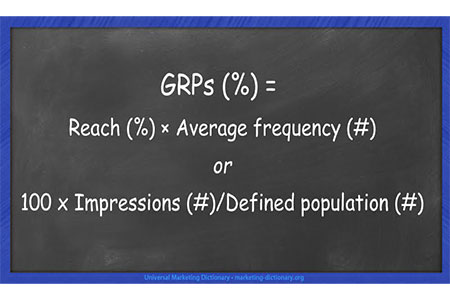Gross Rating Point (GRP)
What is Gross Rating Point?
Full Form of GRP
Gross Rating Point (GRP) is an important ad measure that calculates a campaign's total exposure to a group of people. Symbolizing reach times frequency, it enables advertisers to project the number of times a message can be viewed. GRP stands for the acronym Gross Rating Point.
How to Calculate Gross Rating Point
Gross Rating Point is found by multiplying the reach percentage of the target audience by the frequency of ad exposure. GRP = Reach (%) × Frequency. It is an easy-to-use formula that gives a strong snapshot of the weight of a campaign across media channels.
Example of Gross Rating Point
If an advertisement reaches 40% of the target audience and each person sees it three times, the Gross Rating Point is 120 (40 × 3). This means the total exposure equals 120% of the audience, taking into account repeated views.
What is a Good Gross Rating Point?
A successful Gross Rating Point differs with campaign goals and industry standard but by general rule, a GRP of 100–300 effectively works for brand awareness. For high-intensity, short-term promotions, higher GRPs can produce more impactful recall and effects.

Why is Gross Rating Point Important?
Evaluate Advertising Impact
Gross Rating Point provides a quantifiable means for measuring how well an ad campaign is engaging its audience. It shows the combined strength of frequency and reach, making it possible for marketers to measure visibility and potential effect with accuracy.
Assess Return on Investment (ROI)
GRPs assist in connecting media exposure to business results. Through correlating GRP levels to conversion or sales results, advertisers can more accurately measure ROI, allowing it to be easier to optimize future media investment for greater profitability.
Guide Smart Media Investments
With an understanding of GRP, advertising budgets can be allocated effectively across channels. It ensures that investments are made where audience interaction is greatest, optimizing campaign performance with the least wasted impressions.

How is Gross Rating Point Beneficial?
Measures Audience Reach and Frequency
GRP combines how many individuals view your ad and how repeatedly they view it. This two-pronged insight is vital in measuring campaign saturation and keeping the message in the minds of the target audience.
Supports Strategic Media Allocation
Armed with GRP information, media planners can better allocate budgets across platforms. It streamlines decision-making by identifying which channels provide the greatest value in exposure and engagement.
Enables Cross-Campaign Comparison
Gross Rating Point normalizes campaign performance across media. TV, digital, or radio, GRP allows for apples-to-apples comparisons so that more refined strategies can be done and lessons learned from previous attempts.

Disadvantages of Gross Rating Point
Although GRP is helpful, it is not nuanced. GRP doesn't include audience quality, engagement, or conversion, only exposure. Thus, two campaigns with the same GRP could be drastically different in actual results. Using GRP as the only metric can result in overexposure, wasteful spending, or not taking advantage of better targeting opportunities.

What are the factors that influence Gross Rating Point?
Reach
Reach is the proportion of your target audience who saw an ad at least once. Greater reach boosts GRP and gets your message in front of more potential customers in your target audience.
Frequency
Frequency is a measure of how many times the same individual views an ad. Increased frequency elevates GRP and reinforces memory, but excessive repetition can result in decreased effectiveness or audience exhaustion.
Media Type
Various media, television, radio, and digital, have differing audience sizes and levels of engagement. The type of media has a significant influence on how effectively GRP is built up and how effectively messages are heard across media.
Target Audience
The size and makeup of your target audience directly influence GRP. A clearly defined audience facilitates more concentrated media planning and assists in shaping exposure levels that really deliver campaign objectives.
Ad Placement
Where your ad shows up, prime time TV, homepage banners, or podcast segments, affects reach and visibility. Strategic placement can maximize GRP by putting your message where audience attention is most concentrated.
Duration
The duration an ad runs adds to cumulative exposure. Longer campaigns tend to build higher GRPs, enabling ongoing audience contact and enhancing the chances of message retention.
Content Quality
Even with robust GRPs, weak content can not deliver. A creative's quality determines how memorable a message is, directly affecting the success of each exposure and the actual world value of GRP.

How to Improve Gross Rating Point?
Increase Reach
Reaching out further means appealing to new audience members or leveraging other media channels. The wider the exposure, the greater the number of potential impressions you create, which raises your Gross Rating Point directly.
Boost Frequency
To boost GRP, have the same people view your ad over and over. Repetition is a better recall aid, and tweaking ad timing is a way to reinforce the message without overwhelming the viewer.
Use Multi-Channel Campaigns
Diverse platforms, from social media to broadcast, further facilitate amplitude increases in both reach and frequency. A multi-channel strategy ensures that your audience encounters your message across different touchpoints, thereby raising overall GRP efficiently.
Target the Right Audience
Audience refinement helps produce higher GRPs with better precision. Instead of aiming for scale alone, targeting the right people ensures each exposure has more impact and relevance.
Optimize Ad Scheduling
Timing is important. Advertising at the peak hours or days when your audience is most engaged can significantly enhance exposure and achieve greater GRPs out of the same investment in media.
Enhance Creative Content
More effective content delivers more impact per impression. Attention grabbing, creative ads retain viewers longer, generate engagement, and result in better frequency performance, all contributing to a larger GRP result.
Leverage High-Impact Placements
Placing ads in heavy-traffic or premium locations, such as primetime TV or homepage takeovers, maximizes visibility. They allow you to achieve greater GRPs with fewer, more effective exposures.

What is the Role of Gross Rating Point?
Gross Rating Point is a foundation in media planning that provides a consistent measure of campaign visibility. GRP fills the gap between buying media and measurement performance, enabling advertisers to monitor exposure, budget, and compare strategies across platforms. GRP takes the nuanced world of audience measurement and condenses it into one usable number.
Conclusion
Gross Rating Point is still an important measurement in today's advertising, providing insight into campaign exposure in the form of a combination of reach and frequency. From investment allocation to measuring campaign performance, GRP is instrumental in informing media planning. Used judiciously, it works to transform ad investment into quantifiable, impactful audience action.
FAQs
Yes, GRPs enable advertisers to quantify exposure into TV, digital, radio, and others and hence compare performance better and optimize cross-platform strategies.
GRP is the measure of total audience exposure, whereas TRP, Target Rating Point, only looks into exposing one particular target.
With the use of GRPs, advertisers identify high-performing channels so as not to misuse the budget where the maximum return can be obtained in terms of exposure to the target audience.
Higher GRPs imply that greater numbers of people view an ad more frequently and greatly enhance brand recall and message associations in the consumer's consciousness.
Advertisers should check their GRPs every week or two to track performance and modify strategies in real time for maximum campaign effectiveness.
Supportive metrics such as TRP, CPM (Cost Per Thousand), and ROI provide detailed information about the ad's efficiency, audience targeting, and financial returns.



